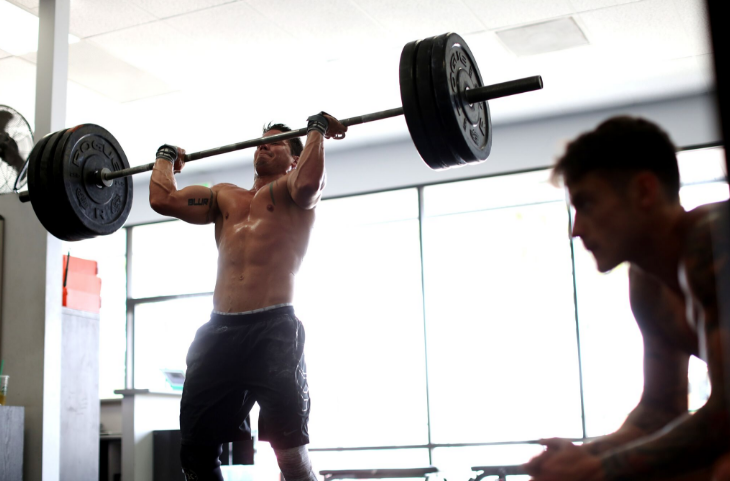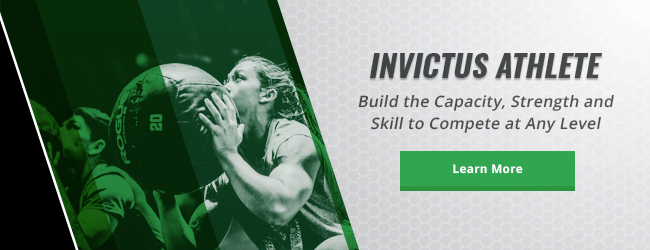
Barbell Cycling Strategies: Ground to Overhead
Written by Nichole Kribs
Thus far in our Barbell Cycling series, we’ve covered the techniques you should use when a workout calls for high reps of Snatch (Muscle, Power and Squat) or Shoulder to Overhead (Push Press and Push Jerk) movements.
To conclude this series, we are going to discuss strategies for cycling when a workout calls for Ground to Overhead.
Ground to Overhead permits either a snatch or clean + shoulder to overhead variation. Unless the movement standard stipulates that certain positions need to be established, it’s up to the athlete to decide how best to get the barbell from the floor to a supported position overhead. The decision will be based on a number of circumstances, such as the prescribed weight, the rep scheme and what other movements are involved in the event/workout. Which variation will be less fatiguing on grip; which will put less strain on the back; etc…? All these things need to be considered. For the purposes of this article, and since we’ve already covered snatch variations, we’re going to review “power clean to overhead” as a primary strategy.
A great example of when this type of Ground to Overhead would be utilized is “Grace.” The weight is not heavy, which makes the workout FAST. An athlete who is gunning for an elite time on this workout needs to be able to cycle the barbell with speed and efficiency. Check out Dan Bailey (we love Dan and his barbell cycling) crush “Grace” by not only his efficient barbell cycling but also going unbroken!
Now, how can you do “Grace” in 1:01 … or at least PR on your “Grace”? Well, one way to improve your “Grace” time is to move the barbell as well as Dan does in that video by following some of the cues below.
Many of the same points for our snatch barbell cycling apply to the power clean portion of this lift. To set up for this, set up with a wider stance; you want to do this for the same reason as with the snatches: (1) it allows you to move quicker than if you were jumping and landing for every rep; and (2) it reduces the range of motion on the travel of the barbell. Watch this video on how to cycle the first portion of a ground to overhead with a wider stance:
Now we are going to build off that power clean and add the overhead portion. Here is the great thing about receiving the barbell in a power clean position – you are already in the dip portion for your shoulder to overhead! That means that once the barbell touches the collarbone, it is an immediate drive with the legs to punch the barbell overhead. Utilizing a push press or a push jerk is up to the athlete and the workout. Watch this video on how to cycle the power clean straight into a shoulder to overhead:
There is a variance with this movement that requires each athlete to test out, which is the descent portion of the movement. There is an opportunity for many touchpoints or zero touchpoints (like Dan did in his “Grace”). Let’s discuss them.
Option 1 – Straight to the ground. This requires the athlete to be diligent about keeping the barbell close on the descent, shooting the hips back and getting the shins vertical to be in a good position for the next rep. Here is a demo of going straight to the ground:
Option 2 – Touchpoint to the shoulders, then straight to the ground. This is often utilized when the weight is manageable for the power clean portion but heavy enough on the shoulders to merit a touchpoint. This touchpoint doesn’t mean that the person rests with the barbell on their shoulder, but rather means that they bring the barbell to their shoulders and then rapidly shoot their hips back and bring the barbell to the ground by quickly getting their elbows over the barbell. Here is a demo of this:
Option 3 – Going straight to the thighs. This may be used if an athlete is used to having a touchpoint on their thigh and/or likes to use the thigh touchpoint to ensure the barbell is close to their body. Regardless, this touchpoint, just like the other options, needs to be fast. The athlete isn’t going to the thigh and hanging out, but rather brushing their thigh with the barbell as the barbell continues to descend to the ground.
I encourage you to try a couple of different options with the descent when doing ground to overhead, especially with different weights. See how each technique feels with a light, medium and heavy weight. Then you will know when to use each technique based on the workout.
Invictus Athlete Programs
If you want an in-depth strategy and a great training program join Invictus Athlete. If you’re over 35, we’re also giving age group strategy for our Invictus Masters. Don’t forget that many of our online programs are now on SugarWOD!
